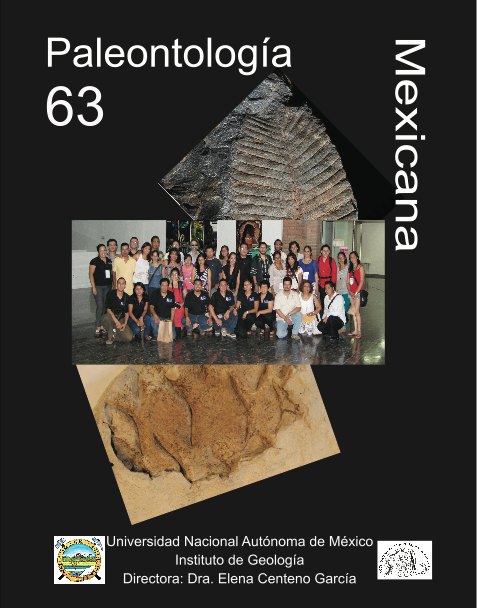Fossil cupressaceous conifers from “El Chango”, Chiapas (Aptian)
Main Article Content
Abstract
In Mexico, conifer fossil record is incomplete and is biased on the north of the country. In recent years work in a quarry located in the Southwestern Mexico, near Ocozocuautla Espinoza, Chiapas, yielded a new interesting biota. The new locality forms part of the Sierra Madre Formation (Aptian), containing flora and fauna from coastal lagoons/estuaries and continental platform. The plant association found on this site is characterized by a high dominance of gymnosperm morphotypes, particularly two conifers. Branches of ultimate and penultimate order of these morphospecies, and a third one represented only by a single fossil, have been assigned to Cupressaceae family based on the presence of mature acicular or thickened at the base scale leaves, with a single central vein, spiral or alternate in crisscross phyllotaxy. Furthermore, based on their architecture, morphometry and phyllotaxis, fossil morphotypes have been compared, finding morphological affinity, with the extant genera Cryptomeria, Glyptostrobus and Chamaecyparis. Today all these genera have a restricted distribution in Asia, but there are previous reports of fossil Glyptostrobus in America. These plants are new records for the Cretaceous of Mexico and complement the biogeographic history of conifers in the country.
Article Details

This work is licensed under a Creative Commons Attribution-NonCommercial-NoDerivatives 4.0 International License.
References
Alvarado-Ortega, J., Ovalles-Damián, E., Blanco-Piñón, A, 2009, The fossil fishes from the Sierra Madre Formation, Ocozocuautla, Chiapas, Southern Mexico: Paleontologia Elec-trónica, 12(2, 4A), 1-22.
Cevallos-Ferriz, S.R.S., 1992, Tres maderas de gimnospermas cretácicas del norte de México: Anales del Instituto de Bi-ología de la Universidad Nacional Autónoma de México Serie Botánica, 63(2), 111-137.
Clement-Westerhof, J.A., 1984, Aspects of Permian palaeobot-any and palynology; IV, The conifer Ortiseia Florin from the Val Gardena Formation of the Dolomites and the Vicentinian Alps (Italy) with special reference to a revised concept of the Walchiaceae (Goeppert) Schimper: Review of Palaeobotany and Palynology, 41, 51-166.
Clement-Westerhof, J.A., 1987, Aspects of Permian palaeobot-any and palynology; VII, The Majonicaceae, a new family of Late Permian conifers: Review of Palaeobotany and Palynol-ogy, 52, 375-402.Crane, P.R., 1987, Vegetational consequences of the angio-sperm diversification, in Friis, E.M., Chaloner, W.C.,
Crane, P.R. (ed), The Origin of Angiosperms and Their Biological Consequences: Cambridge, Cambridge University Press, 107–144.
Eckenwalder, J.E., 2009, Conifers of the World: Portland, Timber Press, 720 pp.
Farjon, A., Page, C.N. (Compiladores). 1999. Conifers. Status survey and conservation action plan: IUCN, Gland, Switzer-land y Cambridge, UK. IUCN/SSC Conifer Specialist Group, reporte, 121 pp.
Farjon, A, 2008, A Natural History of Conifers: Portland, Timber Press, 304 pp.
Farjon, A, 2010, A Handbook of the World’s Conifers: Boston, Brill, 1111 pp.
Florin, R., 1927, Preliminary descriptions of some Palaeozoic conifers: Arkiv für Botanik, 21, p. 1-7.
Galtier, J., Scott, A.C., Powell, J.H., Glover, B.W., Waters, C.N., 1992, Anatomically preserved conifer-like stems from the Up-per Carboniferous of England: Proceedings of the Royal Soci-ety B: Biological Sciences, 247, p. 211–214.
Guerrero-Márquez, G., Calvillo-Canadell, L., Cevallos-Ferriz, S.R.S., Avendaño-Gil, M.J., 2012, Angiospermas de la locali-dad El Chango (Aptiano), de Chiapas, México, VI, en Jornadas paleontológicas y Ier. Simposio de Paleontología en el Sureste de México, Tuxtla Gutiérrez, Chiapas.
Greenwood, D.R., Basinger, J.F., 1994, The paleoecology of high-latitude Eocene swamp forest from Axel Heiberg Island, Canadian High Artic: Review of Palaeobotany and Palynol-ogy, 81(1), p. 83-97.
Hernández-Castillo, G.R., Rothwell, G.W., Mapes, G., 2001, Thucydiaceae fam. nov., with a review and reevaluation of Pa-leozoic walchian conifers: International Journal of Plant Sci-ences, 162, p. 1155-1185.
Hernández-Castillo, G.R., 2005, Systematics of the most ancient conifers: Alberta, Canadá, Faculty of Science of the University of Alberta, tesis doctoral, 324 pp.
Huerta-Vergara, A., Calvillo-Canadell, L., Cevallos-Ferriz, S.R.S., Silva-Pineda, A., 2012, Description and identification of Aptian-Cenomanian Pinaceae and Podocarpaceae from El Chango, Chiapas, Mexico, en Botany 2012, Columbus, Ohio, Botanical Society of America.
Kumagai, H., Sweda, T., Hayashi, K., Kojima, S., Basinger, J.F., Shibuya, M., Fukaoa. Y., 1995, Growth-ring analysis of early Tertiary conifer woods from the Canadian High Arctic and its paleoclimatic interpretation: Palaeogeography, Palaeoclima-tology, Palaeoecology, 116, p. 247–262.
Liu, C.Y., Mohr, B.A.R., Basinger, J.F., 2009, Historical bioge-ography of the genus Chamaecyparis (Cupressaceae, Conife-rales) based on its fossil record: Palaeobiogeography and Pal-aeoenvironment, 89, p. 203-209.
Mapes, G., Rothwell, G.W., 1991, Structure and relationships of primitive conifers: Neues Jahrbuch fuer Geologie und Palae-ontologie Abhandlungen, 183, p. 269-287.
McLoughlin, S., 2001, The breakup history of Gondwana and its impact on pre-Cenozoic floristic provincialism: Australian Journal of Botany, 49, p. 271-300.
Miller, C.N. Jr., 1977, Mesozoic conifers: The Botanical Review, 43(2), p. 217-280.
Ovalles Damián, E., 2004, Determinación taxonómica de un paraclupéido (Teleostei: Clupeomorpha) fósil de la Cantera El Espinal, Ocozocoautla, Chiapas: Tuxtla Gutiérrez: Tuxtla Gutiérrez, México, Universidad de Ciencias y Artes de Chia-pas, tesis profesional, 73 pp.
Powell, G.R., 2009. Lives of Conifers: A comparative account of the coniferous trees, Baltimore, Johns Hopkins University Press, 276 pp.
Sánchez, N., Huguet, L., 1959, Conifers of Mexico: Unasylva (en línea), http://www.fao.org/docrep/x5390e/x5390e04.htm
Scott, A.C., Chaloner, W.G., 1983, The earliest fossil conifers from the Westphalian B of Yorkshire: Proceedings of the Royal Society B: Biological Sciences, 220, p. 163–182.
Vega, F.J., Alvarez, F., Carbot-Chanona, G., 2007. Albian penae-oidea (Decapoda: Dendrobranchiata) from Chiapas, Southern Mexico, en 3rd Symposiumon Mesozoic and Cenozoic Decap-oda Crustaceans, Museo di Storia Naturale di Milano: Memo-rie della Societá Italiana di Scienze Naturali e del Museo Civ-ico di Storia Naturale di Milano, 35(2), p. 6-8.
Weber, R., 1980, Megafósiles de Coníferas del Triásico Tardío y del Cretácico Tardío de México y Consideraciones Generales Sobre las Coníferas Mesozoicas de México: Revista del In-stituto de Geología de la Universidad Nacional Autónoma de México, 4(2), p. 111-124.
Wittlake, E.B., 1970, Glyptostrobus europaeus (Brongn) Heer in Arkansas: Arkansas Academy of Science Proceedings, XXIV, 44-47.
